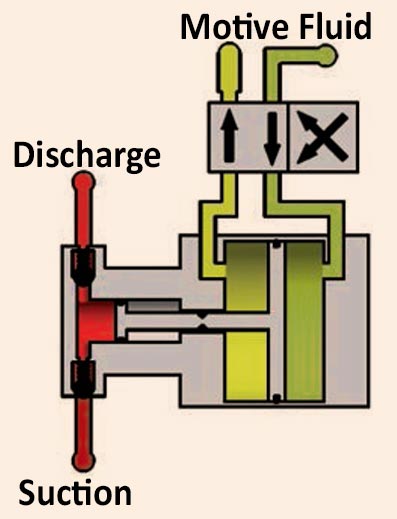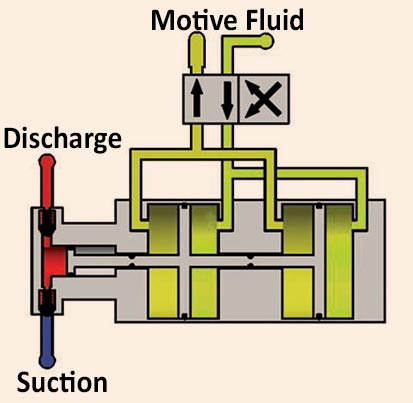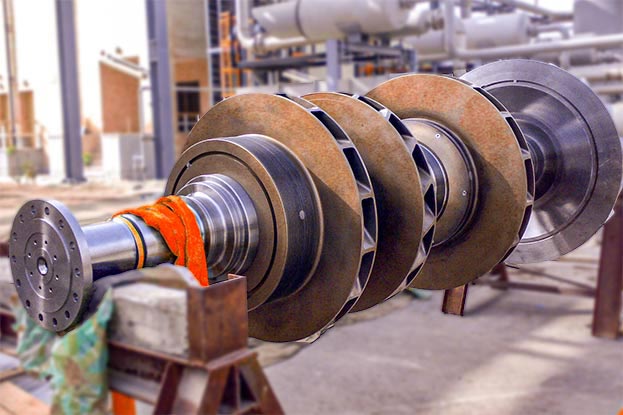Pumps are one of the mostly used equipment in oil, gas and petrochemical industry. Pumping equipment is extremely diverse, varying in type, size, driver and materials of construction. Pumps are classified into two fundamental types based on the manner in which they transmit energy to the pumped liquid: kinetic or positive displacement. In a kinetic type, a centrifugal force of the rotating element, called an impeller, force kinetic energy to the fluid, moving the fluid from pump suction to the discharge. On the other hand, positive displacement uses the reciprocating action of one or several pistons, or a squeezing action of meshing gears, lobes, or other moving bodies, to displace the liquid from one area into another.
In this article, we will introduce some frequently used pump types in oil and gas field and briefly review their specifications as a useful selection guide.
Main contents:
Types of pumps
In oil and gas industry, pumps are categorized into various groups according to the bellow graph. Kinetic and positive displacements are two main classes, which have different working principles. Kinetic pumps are of centrifugal type. Whereas positive displacement pumps are divided into rotary (such as vane, gear and screw) and reciprocating (such as piston, plunger and diaphragm) types.

Centrifugal pumps
In centrifugal pumps, which is a kind of kinetic type, kinetic energy is transmitted into the fluid using a rotating element, known as impeller. This causes an increase in fluid’s velocity at the end of impeller, which then is converted to pressure at the outlet of the pump. The conversion of kinetic energy to pressure often takes place at either volute or diffuser. This conversion is based on Bernoulli’s principle. According to Bernoulli’s principle, pressure of an incompressible fluid increases as its velocity decreases. Both volute and diffuser have an increasing cross-sectional area along the fluids path that make the fluid’s velocity decrease. As for axial centrifugal pumps however, a propelling or lifting action of the vane on the liquid produces the required head. In this type of centrifugal pumps, the diameter of the impeller is the same at the suction and discharge side. Centrifugal pumps are economical pumps comparing to other types. Maximum discharge pressure is around 500 bar.
Due to the importance of this type of pumps, we will review centrifugal pumps in detail in the upcoming articles.

Centrifugal pump
Centrifugal pump animation
Positive displacement
Positive displacement pumps are intended to move the fluid forward by trapping and pushing it along the casing, instead of throwing the fluid as in centrifugal pumps. Therefore, positive displacement pumps do not increase the fluid’s pressure unless there is a resistance in fluid’s way downstream of the pump. Unlike centrifugal pumps, which can only generate a limited head rise, in positive displacement pumps, pressure increase is dependent to pump’s downstream condition. As a result, these pumps are capable of generating large pressure difference and are suitable for high-pressure applications. Normally, there shall be a pressure safety valve at discharge line of these pumps due to almost unlimited pressure rise. Generally, in oil and gas applications, positive displacement pumps are not as common as centrifugal pumps. API Standards 674, 675 & 676 cover the minimum requirements for positive displacement pumps and pump’s unit for use in petroleum, petrochemical and gas industry services. They are only used for specific applications as bellows:
- Metering (dosing) applications where there is a need for addition of precise amount of chemical into process fluid.
- Extremely high-pressure applications where centrifugal pumps are not able to operate.
- Applications with low flowrate where the use of centrifugal pumps is not economical due to low efficiency.
- Direct-acting steam driven, in which the motive steam is directly used as source of power.
- Pumping of high viscosity liquids such as turbo-machinery lube oil.
Rotary Pumps
Rotary pumps, which are a kind of positive displacement class, consist of a fixed casing containing vanes, gears, screws, etc., operating with minimum clearance. Their working principle is by trapping the liquid pushing it around the casing, causing a smooth flow at the outlet. Maximum discharge pressure in rotary pumps is not as high as other types. Most frequently used rotary pumps are screw, gear, lobe and vane.
Screw pumps
Screw pumps typically consist of two suitably threaded screws turning in a fix casing. Their working principle is like meat grinders. Fluid is trapped and transported between the screw threads, along the axis of screw. A large number of other designs are also available with one or three treaded screws.

Screw pump
Screw pump animation
Gear pumps
Gear pumps are the simplest rotary pumps. There are two types of gear pumps. External and internal gear pump. External-gear pump consist of two rotating gears. One is connected to the shaft meshing with the idler gear, which can rotate freely. These gears rotate at opposite directions. As the gear teeth separate on the suction side of the pump, liquid fills the spaces between them due the partial vacuum condition. Then it is carried around and squeezed out through the discharge nozzle as gears rotate. The clearance between gears and casing wall is so small that the slippage rate of the trapped liquid is negligible for the highly viscous fluids. Main application is for pumping of lubrication oil.

Gear pump
Gear pump animation
Screw vs Gear: side-by-side comparison
In general, screw pumps can be a better choice for industrial applications rather than gear pumps due to the following reasons:
- Higher suction capacity
- Lower noise, vibration and turbulency
- Capable of higher rotational speed up to 3500 rpm
- Smaller casing and footprint for a constant capacity
- Smother discharge flow with less pulsation
- Screw pumps have a longer operational life
Lobe pumps
Lobe pumps resemble gear pumps in action. They have two or more rotors cut with two, three or more lobes on each rotors. As the lobes rotate the liquid fills the space between lobes and casing’s wall and pushed out through the discharge nozzle. Because liquid is delivered in smaller number of larger quantities than in gear pumps, the liquid flow is not as constant as from the gear pumps. Lobe pumps can be utilized as vacuum packages in order to create partial vacuum condition.

Lobe pump
Lobe pump animation
Vane pumps
The most common vane pump is the sliding vane pumps. their working principle is based on sliding vanes rotating about a non-concentric cam. These vanes are held against the casing bore by centrifugal force when the rotor is turned. In some other designs, the vanes are pushed out by means of springs. Because the rotating vanes are in a non-concentric casing, the free space between vanes gets larger as the rotor turn around at the suction side forcing the liquid into the pump’s inlet. At the discharge though, the trapped liquid is compressed due to the smaller area increasing the outlet pressure. Rotary vane pump is the primary choice for vacuum pumps. Because of vanes touching the casing’s wall, the risk of abrasion is high in these pumps. In order to tackle this problem, vane pumps are often utilized with an inner oil or liquid ring.
- Oil sealed vane pump has a thin layer of oil covering the casing’s inner wall. Because of centrifugal forces, this layer distributes evenly all around the casing. They are mainly used as gas compressors and vacuum pumps.
- Liquid ring vane pump has an impeller with fixed vanes. Its casing is fed by Liquid (usually water based) and – by centrifugal acceleration – this liquid forms a moving cylindrical ring against the inside of the casing. This liquid ring creates a series of seals in the space between the impeller vanes. The eccentricity between the impeller’s axis of rotation and the casings geometric axis results in a cyclic variation of the volume enclosed by the vanes and the ring. This compresses the gas and discharges it through discharge nozzle. Liquid ring vane pumps are used as vacuum pumps and gas compressors.

Vane pump
Vane pump animation
Reciprocating pumps
Reciprocating pumps, which are a kind of positive displacement class, discharge a definite quantity of liquid by piston or plunger movement through the stroke distance. The volume of liquid displaced during one stroke of piston or plunger is proportional to the piston cross-sectional area and stroke length. Reciprocating pumps often provide less smooth flow at discharge with periodic pulsation. To solve this issue, it is a good practice to consider a pulsation dampener downstream of the pump. By means of power driver, reciprocating pumps are classified as bellow:
- Direct acting steam-driven: In this configuration, the pumping energy is obtained directly from steam at the opposite chamber. A common rod connects the steam piston to liquid piston. By letting the steam into and out of the steam chamber, the reciprocating action can be achieved. The reciprocating power then, transmitted to liquid chamber to provide pumping power. Note that apart from steam, any high-pressure fluid can be used as motive to provide the required power. Direct acting pumps can be designed as two/three drive units to achieve higher pressure. In this configuration, there are two/three separate chambers connected to a same piston rod. Motive fluid enters into two/three separate chambers simultaneously and provide the compression power at the same time. The discharge line of each chamber then combine together as exhaust.
- Power pumps: In this configuration, a crankshaft is driven from an outside source, often an electric motor or a steam turbine. Gears are used to adjust the output speed of the driver. Power pumps are capable of operating in higher speed than direct acting pumps.
Reciprocating pumps are classified into three common groups- piston, plunger and diaphragm pumps.

Single-acting one-drive steam driven pump

Single-acting two-drive steam driven pump
Piston pumps
Piston pumps are the simplest reciprocating pumps. They resemble internal combustion engine of conventional cars. They consist of an inlet and outlet check valves and a crankshaft connected to a disk (piston). The piston reciprocates in an enclosed cylindrical chamber. In the expansion stage, the piston goes back allowing the fluid sucked into the chamber through the inlet valve. In the compression stage, the piston compresses the fluid forcing it out through the discharge valve. In order to have a smoother discharge flowrate with higher capacity, these pumps are designed in double acting configuration. In double acting pumps, both sides of the piston are in contact with the liquid. While one side is in compression mode the other side is experiencing expansion. Therefore, the discharge of the pump has a continuous flowrate with less pulsation. As a rule of thumb, maximum pressure rise, which can be obtained by piston pumps, is 150 bar.

Double-acting one-drive piston pump
Piston pump animation
Plunger pumps
Plunger pumps are almost identical to piston pumps with the same working principle. Except they use a plunger instead of a piston. A plunger is thicker than a piston rod. Therefore, the chance of buckling in high pressure decreases. As a result, they can withstand higher pressure and are suitable for extremely high-pressure applications. Unlike piston type in which the liquid is only in contact with a disk, in plunger type, the entire plunger is in contact with the liquid. If poorly design, their main drawback would be the leakage of pumping liquid to the environment. Due to high flow pulsation, they require pulsation dampener at both suction and discharge lines, especially for one-stage plunger pumps. As a good engineering practice, the dampener capacity shall be three times higher than one complete pump’s stroke.

Plunger pump
Plunger pump animation
Diaphragm pumps
Diaphragm pumps are a combination of a piston and diaphragm. Their working principle are similar to piston pumps. They have a rod or plunger, which push against a diaphragm to compress the containing liquid by means of a crankshaft. The liquid is in contact with the diaphragm. They are only use for small capacities like dozing applications in which an exact discharge flow is expected. The diaphragm is often made from flexible nonmetallic material like PTFE to withstand the corrosive and erosive environment. Diaphragm pumps are short-stroke high speed pumps comparing to other reciprocating pumps. They are often utilized as metering pumps to handle acid and alkaline chemicals.

Diaphragm pump animation
Pump’s characteristics at a glance
-A Selection Guideline-
In the following table, the most important specifications of each pump types are provided as a quick engineering selection guide.
| Pump type | Specifications |
|---|---|
| Centrifugal | -Economical -Smooth discharge flowrate -Suitable for almost all types of fluids: dirty- abrasive … -Flowrate decreases with head rise -Suitable for high capacity -Efficiency drops by low flowrate -Indirectly increases pressure by increasing velocity first –Cavitation is a major problem at impeller |
| Gear | -Relatively low capacity -Smooth discharge flowrate -Suitable for viscous fluids -Suitable for pumping lubrication oil |
| Screw | -Less noise, vibration and pulsation than gear pumps -Smaller footprint than gear pumps for a given capacity -Smooth discharge flowrate -Suitable for pumping lubrication oil |
| Vane | -Best choice for vacuum pumps -Relatively low capacity -Prone to abrasion due to probable internal touching parts |
| Plunger | -Suitable for high pressure applications -Flowrate is independent of discharge pressure -Require a PSV at discharge line -Can be used as direct-acting steam driven -Pulsation at discharge flowrate |
| Diaphragm | -Flowrate is independent of discharge pressure -Low capacity with small stroke -Suitable for metering pumps with adjustable stroke -Easily handle corrosive and erosive services -Pulsation at discharge flowrate |


Nice job